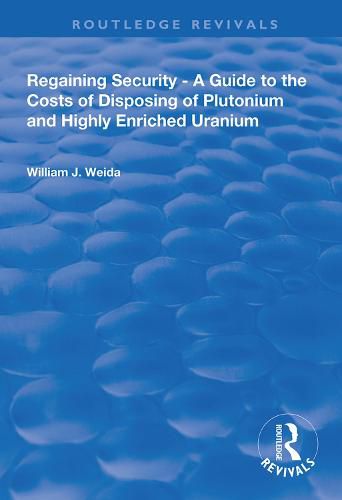Readings Newsletter
Become a Readings Member to make your shopping experience even easier.
Sign in or sign up for free!
You’re not far away from qualifying for FREE standard shipping within Australia
You’ve qualified for FREE standard shipping within Australia
The cart is loading…






First published in 1997, this volume observes that of all the materials, systems and facilities that designed and operated nuclear weapons, the most readily available assets for reuse are often identified as the highly enriched uranium (HEU) and plutonium from warheads. However, proliferation concerns the reuse of much of this material unlikely. This book explores the economic issues surrounding the major expenditures facing the US as it attempts to dispose of weapon-grade nuclear materials in a proliferation-resistant manner. The book discusses the economic values of plutonium and HEU, the economic nature of the nuclear industry, reprocessing and operations costs, the economics of ‘burning’ plutonium to generate electrical power, the economics of down-blending and ‘burning’ HEU, military conversion as a rationale for selecting plutonium disposition options, the economics of transmutation, and the economics of other proposals ranging from monitored surface storage to vitrification. The book concludes by identifying the major cost drivers affecting all disposition options.
$9.00 standard shipping within Australia
FREE standard shipping within Australia for orders over $100.00
Express & International shipping calculated at checkout
First published in 1997, this volume observes that of all the materials, systems and facilities that designed and operated nuclear weapons, the most readily available assets for reuse are often identified as the highly enriched uranium (HEU) and plutonium from warheads. However, proliferation concerns the reuse of much of this material unlikely. This book explores the economic issues surrounding the major expenditures facing the US as it attempts to dispose of weapon-grade nuclear materials in a proliferation-resistant manner. The book discusses the economic values of plutonium and HEU, the economic nature of the nuclear industry, reprocessing and operations costs, the economics of ‘burning’ plutonium to generate electrical power, the economics of down-blending and ‘burning’ HEU, military conversion as a rationale for selecting plutonium disposition options, the economics of transmutation, and the economics of other proposals ranging from monitored surface storage to vitrification. The book concludes by identifying the major cost drivers affecting all disposition options.